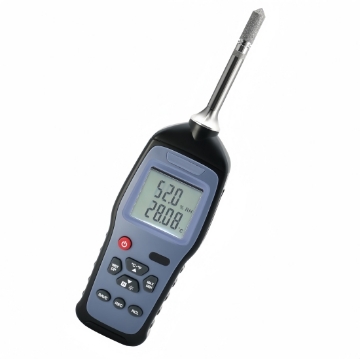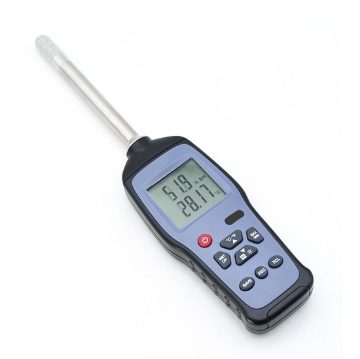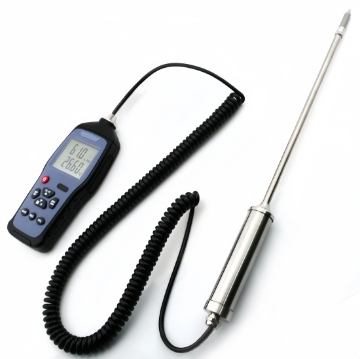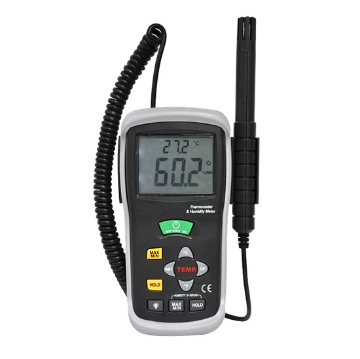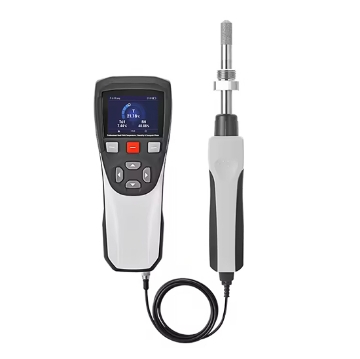Dew Point Meters
Portable Dew Point Meter for Compressed Air
Portable Dew Point Meter with Wet Bulb
Handheld Dew Point Meter with Removable Probe
Digital Handheld Dew Point Meter with LCD Backlight
Digital Dew Point Meter with Wet Bulb
Dew Point Temperature Meter with Wet Bulb
Handheld Temperature Humidity Dew Point Meter
A dew point meter is a precision instrument used to measure the water vapor content in a gas. It determines the moisture content by measuring the dew point temperature of the gas. To better understand the working principle of a dew point tester, you need to first understand the functions of a dew point meter. In addition to being able to measure dew point temperature, a dew point meter can also measure temperature, humidity, and wet bulb. There are two more professional terms here, namely dew point temperature and wet bulb.
Dew Point Temperature
Dew point temperature refers to the temperature at which the water content in the gas reaches saturation under a certain air pressure and forms water droplets on its surface, that is, the temperature at which the water vapor in the air begins to condense into liquid water. It is an important indicator for measuring the humidity of the gas.
Dew point temperature is not only a parameter in meteorology that describes the state of water vapor in the air, but also has wide applications and practical significance in many fields such as industrial production, meteorology, environmental science, industrial applications, and daily life. By accurately measuring and calculating the dew point temperature, a series of problems caused by humidity can be effectively prevented and solved, thereby ensuring production quality and environmental comfort.
- Humidity Indication
Dew point temperature is an important indicator for measuring the water vapor content in the air. The higher the dew point temperature, the more water vapor content in the air, and the higher the relative humidity. - Weather Forecast
In weather forecasts, dew point temperature is used to determine the possibility of cloud formation. If the dew point temperature is close to or equal to the air temperature, then the water vapor in the air is likely to condense into clouds, which may indicate changes in weather conditions. - Comfort Assessment
Dew point temperature can be used to assess human comfort. When the dew point temperature is high, the humidity in the air is also high, people will feel more stuffy, it is not easy to dissipate heat, and therefore feel uncomfortable. - Air Conditioning and Dehumidification
In air conditioning and dehumidification systems, the dew point temperature is an important reference factor for design. The dehumidification effect can be achieved by lowering the air temperature below the dew point temperature. - Warehousing and Transportation
During warehousing and transportation, the dew point temperature can help control the ambient humidity and prevent the goods from being damaged by moisture, especially for items that are susceptible to moisture, such as food, medicines, and electronic products. - Aviation Safety
In the aviation field, the dew point temperature is crucial to flight safety. Aircraft icing mainly occurs under conditions below the dew point temperature, so understanding the dew point temperature helps pilots and ground control personnel determine whether there is a risk of icing. - Agricultural Irrigation
In agricultural irrigation, the dew point temperature can be used to estimate the transpiration of crops and the evaporation rate of soil moisture, helping to determine the best time for irrigation. - Environmental Monitoring
In environmental monitoring, the dew point temperature is one of the important parameters for monitoring air quality, which can reflect the humidity and condensation of pollutants in the atmosphere.
Wet Bulb Temperature
The wet bulb is an important meteorological concept. It refers to the lowest temperature that can be reached by evaporation of water when the air humidity reaches 100% under certain conditions. This concept is mainly used to measure and describe air humidity in daily life, and it is also one of the important factors in evaluating thermal comfort.
There is a certain relationship between wet bulb temperature, dry bulb temperature, and dew point temperature. For unsaturated air, the dew point temperature is lower than the wet bulb temperature, and the wet bulb temperature is lower than the dry bulb temperature. For saturated air, these three temperatures are equal.
The significance of wet bulb temperature in practical applications is that it can reflect the degree of saturation of moisture in the air. When the difference between the wet bulb temperature and the dry bulb temperature is large, it means that the relative humidity of the air is low and the evaporation of moisture is strong; on the contrary, when the difference between the two is small, it indicates that the air humidity is high. In addition, wet bulb temperature is also an important parameter for measuring human thermal comfort, because it is associated with the evaporation of human sweat and affects the heat dissipation efficiency of the human body. It plays an important role in the design of air conditioning systems in buildings, antifreeze measures for crops, and public health management. With the challenges brought by global climate change, it is becoming increasingly important to understand and monitor wet bulb temperature.
The development of the dew point meter has gone through many different technical methods, which can be mainly divided into mirror type, cold mirror method, and resistance-capacitance method. In many fields such as industry, environment, power, etc., the detection of dew point is of great significance. The use of dew point meters has an important impact on the quality control and production efficiency of enterprises. For example, in the pharmaceutical and food industries, a dew point meter can ensure the stability of the production process and product quality, and strict control of the moisture content in the gas is crucial to the shelf life and taste quality of the product. In the chemical and power industries, accurate control of the moisture content in steam can significantly improve the operating efficiency and energy efficiency of the equipment. A dew point meter can also be used to monitor the water vapor content in the atmosphere and provide data support for climate change research. In the field of power, a dew point meter is used to measure the moisture content in fuel gas to help optimize the combustion process and improve energy efficiency.
In general, the dew point meter is a precision instrument widely used in various industries, which is of great significance for ensuring product quality, improving production efficiency, and scientific research.

